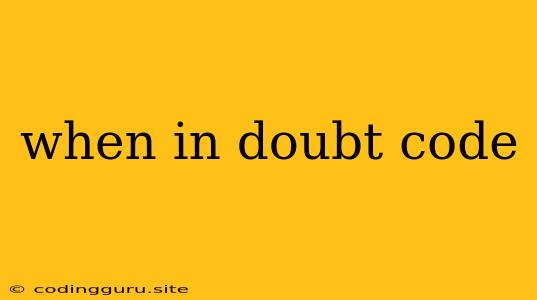When in Doubt, Code: A Developer's Mantra
In the ever-evolving world of software development, uncertainty is a constant companion. From navigating complex frameworks to debugging elusive errors, developers often find themselves at crossroads, unsure of the best path forward. But amidst the doubt and confusion, there's a simple yet powerful mantra that can guide you: when in doubt, code.
This isn't just a catchphrase; it's a philosophy that empowers you to overcome roadblocks and unlock solutions. Let's explore why this approach is so effective and how you can harness its power in your own coding journey.
The Benefits of Embracing "When in Doubt, Code"
1. Testing and Experimentation: The beauty of coding is that it allows you to test your hypotheses and explore possibilities. When faced with uncertainty, writing code to simulate different scenarios or test your ideas is often the quickest way to gain clarity.
2. Identifying Blind Spots: Sometimes, the act of writing code reveals flaws or limitations in your initial understanding. You might discover missing requirements, realize a design pattern is not optimal, or identify edge cases you hadn't considered.
3. Iterative Development: Coding is a process of continual refinement. By starting with a basic implementation and iterating upon it, you can gradually work towards a robust solution, eliminating doubts along the way.
4. Real-World Validation: No amount of theoretical knowledge can replace practical experience. Coding provides immediate feedback and allows you to see how your ideas translate into tangible results.
5. Boosting Confidence: Successfully writing code to solve a problem, no matter how small, builds confidence and empowers you to tackle more challenging tasks in the future.
Practical Tips for "When in Doubt, Code"
1. Break Down the Problem: Don't get overwhelmed by complexity. Divide the problem into smaller, more manageable pieces. Focus on writing code for a single component at a time.
2. Start Simple: Don't strive for perfection right away. Begin with a basic implementation that addresses the core functionality. You can always refactor and add more features later.
3. Comment Your Code: Clear, concise comments will help you understand your code later on and make it easier for others to collaborate.
4. Use Version Control: Utilize tools like Git to track your changes. This allows you to experiment freely, knowing that you can always revert to a previous version if needed.
5. Seek Feedback: Don't be afraid to ask for help from colleagues or mentors. They can provide valuable insights and point you in the right direction.
Examples of "When in Doubt, Code" in Action
Scenario 1: You're building a web application and unsure of the best way to handle user authentication.
Solution: Write a simple prototype for both authentication methods you're considering. Experiment with each approach, analyze performance, and make a decision based on your findings.
Scenario 2: You're implementing a complex algorithm and unsure if your code is optimized for speed.
Solution: Code different versions of the algorithm, compare execution times, and identify areas for improvement.
Conclusion
"When in doubt, code" is a powerful mantra for developers of all levels. It encourages a hands-on approach, fostering experimentation, learning, and problem-solving. Embrace this philosophy, and watch as your coding skills flourish and your confidence grows.
